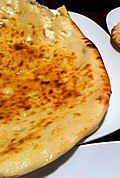Naan: Difference between revisions
CSV import Tags: mobile edit mobile web edit |
CSV import |
||
| Line 28: | Line 28: | ||
[[Category:Middle Eastern cuisine]] | [[Category:Middle Eastern cuisine]] | ||
{{food-stub}} | {{food-stub}} | ||
<gallery> | |||
File:Annapurna_Naan.jpg|Annapurna Naan | |||
File:Naan_Bakery,_Iran,_Qajar_era_(circa_1850).jpg|Naan Bakery, Iran, Qajar era (circa 1850) | |||
File:Bread_of_Afghanistan_in_2010.jpg|Bread of Afghanistan in 2010 | |||
File:Naan_in_Afghanistan.jpg|Naan in Afghanistan | |||
File:نان_مزاری.jpg|Naan | |||
File:Indian_naan_bread.jpg|Indian naan bread | |||
File:Peshawari_Roti,_Pakistan.jpg|Peshawari Roti, Pakistan | |||
File:二道桥_馕店2.jpg|Naan | |||
File:Baking_bread_by_nomad_women_in_Lar_National_Park.jpg|Baking bread by nomad women in Lar National Park | |||
File:Iranian_Bread_1.JPG|Iranian Bread | |||
File:Naan_Sangak.jpg|Naan Sangak | |||
File:Taftan_nan_01.jpg|Taftan nan | |||
File:Butter_Garlic_Naan.jpg|Butter Garlic Naan | |||
</gallery> | |||
Latest revision as of 21:28, 20 February 2025
Naan is a type of leavened bread traditionally associated with the cuisine of the Indian subcontinent. The bread is typically baked in a tandoor, or clay oven, which gives it its distinctive taste and texture.
History[edit]
The word "naan" comes from the Persian language and means "bread". The first recorded history of naan can be found in the notes of the Indo-Persian poet Amir Khusrow, which dates this bread to 1300 AD. The naan was a popular breakfast choice among the royals during the Mughal era in India.
Preparation[edit]
Naan is made from wheat flour, water, and a leavening agent. The dough is kneaded and then left to rise before being rolled out and cooked in the tandoor. Some variations of naan may also include yogurt, milk, or eggs in the dough to give it a softer texture.
Varieties[edit]
There are many varieties of naan, including garlic naan, which is topped with minced garlic and butter, and Peshawari naan, which is stuffed with a mixture of nuts and raisins. In some parts of the Middle East, naan is served with kebabs or used to scoop up curry or dal.
Cultural Significance[edit]
Naan holds a significant place in Indian and Middle Eastern cuisines. It is often used as a utensil to scoop up other foods, and is a staple in meals, particularly in North India.
See Also[edit]
-
Annapurna Naan
-
Naan Bakery, Iran, Qajar era (circa 1850)
-
Bread of Afghanistan in 2010
-
Naan in Afghanistan
-
Naan
-
Indian naan bread
-
Peshawari Roti, Pakistan
-
Naan
-
Baking bread by nomad women in Lar National Park
-
Iranian Bread
-
Naan Sangak
-
Taftan nan
-
Butter Garlic Naan













